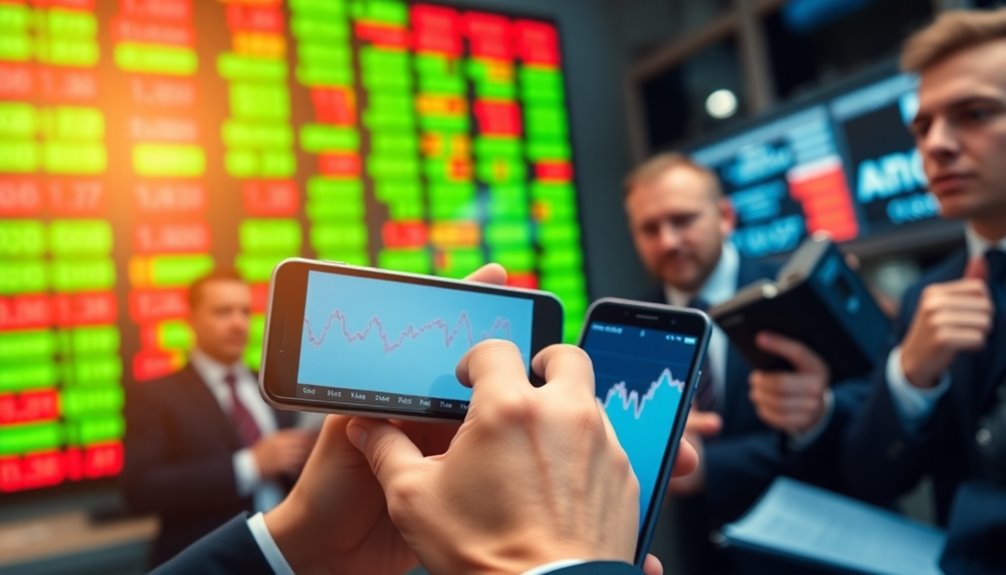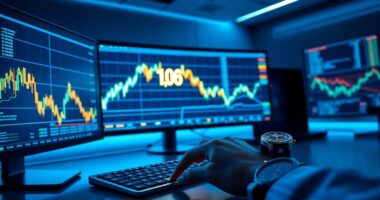A volatile investment is an asset that experiences significant price fluctuations, often driven by market sentiment, economic changes, and external events. This unpredictability can create both opportunities for high returns and the risk of steep losses. If you're considering volatile investments, it's crucial to understand the implications of market trends and your own risk tolerance. While these assets can offer exciting prospects, they might not align with short-term financial goals due to their inherent unpredictability. To make informed choices, you'll want to explore effective strategies for managing these risks and enhancing your portfolio's performance.
Key Takeaways
- Volatile investments are assets that experience significant price fluctuations over short periods, influenced by various economic and external factors.
- They can offer high potential returns, but also carry increased risks, making them unsuitable for risk-averse investors.
- Market sentiment, driven by emotions like fear and greed, greatly affects the volatility of these investments.
- Diversification across asset classes can help mitigate risks associated with volatile investments by spreading exposure.
- Effective risk management strategies, such as regular portfolio rebalancing, are essential when dealing with volatile investments.
Investment Price Fluctuations

Investment price fluctuations are an inevitable part of the market landscape, especially when you consider the various factors at play. Economic conditions, like inflation rates and growth trends, can significantly sway stock prices. When central banks adjust interest rates, you'll often see immediate impacts on market volatility. External events, such as natural disasters or geopolitical tensions, can create surprising price swings, while political events and seasonal changes also play a role. Additionally, your own sentiment and behavior, along with those of other investors, can drive fluctuations. Understanding these influences helps you navigate the unpredictable nature of investments, as geopolitical events can introduce uncertainty and volatility in stock markets.
Understanding Market Unpredictability

Market volatility stems from a complex web of factors that contribute to unpredictability. Changes in consumer behavior can shift market dynamics overnight, while rapid technological advancements can render existing products obsolete. Government policies and regulations, particularly unanticipated ones, can create additional uncertainty. Global political developments, like elections or geopolitical unrest, further complicate the landscape. Economic factors like inflation and interest rate fluctuations can erode consumer purchasing power and increase borrowing costs. Additionally, external emergencies, such as pandemics or wars, disrupt supply chains and heighten market risks. These factors create a high level of market uncertainty that businesses must learn to navigate effectively. Understanding production quantity variance is essential in this unpredictable environment, as it helps companies adjust their production plans and manage inventory more effectively. When combined, these elements lead to market mispricing and distortions, ultimately affecting investor confidence and causing erratic stock price movements, making the investment landscape challenging to navigate.
Market Sentiment Drives Volatility

While various factors contribute to fluctuations in the stock market, you can't overlook how market sentiment plays a pivotal role in driving volatility. Positive sentiment often leads to increased buying, driving prices higher, while negative sentiment triggers selling and downward pressure on prices.
Economic indicators, company earnings, and geopolitical events all shape sentiment, but emotions like fear and greed can amplify its effects. The herd mentality among investors can escalate volatility, as irrational decisions lead to rapid price swings. Moreover, the speed of news dissemination through social media can spark immediate reactions, further influencing sentiment. Ultimately, understanding market sentiment is crucial, as it directly impacts price movements and creates an unpredictable investment landscape. This is particularly evident during periods of strong sentiment shifts, which can lead to increased volatility.
Pros and Cons of Volatility

Understanding the pros and cons of volatility is essential for any investor navigating the financial landscape.
On the upside, volatile investments can offer the potential for high returns and diversification, helping you meet long-term financial goals. They can signal market opportunities, allowing you to capitalize on undervalued assets. Additionally, high volatility may attract aggressive investors seeking growth.
However, the risks are significant. The unpredictability of volatile markets can lead to anxiety and impulsive decisions, especially if you're not prepared for rapid price changes.
Moreover, if you're targeting short-term financial goals, volatile investments may not be suitable due to their potential for sharp losses.
Balancing these factors is crucial as you craft your investment strategy.
Volatility Versus Stability

When you weigh your investment options, it's essential to consider the trade-offs between volatility and stability.
Volatile investments, like stocks, can experience dramatic price swings, leading to higher potential gains but also greater risks. On the other hand, stable investments, such as government bonds and cash, show much less price fluctuation, providing you with a sense of security. While high volatility might signal uncertainty in the market, stable options often help maintain consistent returns over time. Historical volatility is calculated from past price data, which can help investors better understand the potential risks of their volatile investments.
Diversifying your portfolio by blending volatile and stable investments can effectively manage overall risk, allowing you to pursue growth while safeguarding against significant losses. This balance is crucial in aligning your investment strategy with your financial goals and risk tolerance.
Investment Loss Potential

Investment loss potential is a critical factor to grasp as you navigate your investment journey. Understanding volatility helps you gauge the range of price changes an investment might experience, indicating possible risks.
You need to weigh the risk/return ratio to assess whether the potential gains outweigh the possible losses. Keep in mind that the real danger isn't just temporary fluctuations but the permanent loss of capital if your investment doesn't recover. A lower risk/reward ratio can signify better potential rewards compared to risks, guiding your investment decisions.
Using historical data and fundamental analysis can help you estimate potential outcomes. Additionally, diversifying your portfolio across various asset classes allows you to manage risk effectively while aligning with your financial goals.
Stay vigilant and adjust your strategy based on market conditions to protect your investments.
Emerging Markets' Volatility Spikes

As global economic conditions shift, emerging markets often experience volatility spikes that can catch investors off guard. Factors like changing U.S. interest rates and a fluctuating dollar directly impact these markets. Domestic political issues, such as leadership changes in India and Japan, can lead to unpredictable equity movements. Inflation and rising costs squeeze consumer spending, affecting earnings growth. Additionally, uncertainty surrounding U.S. policies can cause turbulence, especially with potential higher interest rates. However, economic stimulus plans, particularly from China, may provide some stability. Emerging markets showed resilience in 2024 despite global macro headwinds, indicating that there are opportunities even in turbulent times. Understanding diversification strategies can also mitigate risks associated with these investments.
Despite these challenges, understanding the underlying dynamics can help you navigate the turbulent waters of emerging markets, allowing for better investment decisions amidst the volatility.
Diversify Across Asset Classes

Navigating the unpredictable nature of emerging markets highlights the importance of diversifying across asset classes. Different asset classes behave uniquely; for instance, stocks and bonds often move in opposite directions. While equity markets might thrive during rising interest rates, bond prices could drop. It's also essential to consider how state taxes on IRA withdrawals can impact your retirement income, particularly in states with significant tax implications.
By incorporating alternative assets like real estate, cryptocurrencies, and commodities, you can create a more resilient portfolio against macroeconomic changes. Effective strategies enhance performance while protecting against risk and should be a key consideration in your investment approach.
Aim for broad diversification, including traditional investments such as stocks and bonds, along with geographically diverse options. Additionally, understanding state-specific tax laws can help you make informed decisions about your investment withdrawals.
Don't forget about sector and industry diversification; mixing investments across sectors and company sizes can further mitigate risk.
Ultimately, spreading your investments across uncorrelated assets increases your risk-adjusted returns and helps preserve wealth, especially important as you approach retirement.
Frequently Asked Questions
How Can I Identify Volatile Investments Before Purchasing?
To identify volatile investments before purchasing, you'll want to look at specific metrics.
Check the stock's standard deviation and beta; higher values indicate greater volatility.
Also, examine price charts for erratic movements.
Keep an eye on maximum drawdown to understand potential losses.
Finally, consider market conditions and sector volatility, as some sectors naturally fluctuate more than others.
Diversifying your portfolio can also help manage risk associated with volatile investments.
What Roles Do Economic Indicators Play in Investment Volatility?
Economic indicators play a crucial role in investment volatility. By tracking GDP growth rates, unemployment rates, and consumer price indices, you can assess economic health and market trends.
A rising GDP might boost your confidence in stocks, while high unemployment could signal trouble. Keeping an eye on these indicators helps you anticipate changes in market conditions, allowing you to make informed investment decisions and manage potential risks effectively.
Are Certain Industries More Prone to Volatility Than Others?
Some industries certainly dance to a more unpredictable tune, don't they?
Sectors like technology and energy often experience significant price swings due to rapid innovations and fluctuating commodity prices.
Biotechnology and pharmaceuticals can feel the pressure from regulatory hurdles and clinical trial results, while consumer discretionary stocks are sensitive to shifts in public sentiment.
Understanding these nuances can help you navigate the investment landscape more wisely and prepare for those unexpected market moves.
How Do Geopolitical Events Impact Investment Volatility?
Geopolitical events can significantly impact investment volatility. When tensions rise, you'll likely see a shift in investor sentiment towards safer assets, causing stock indices to drop, especially in emerging markets.
This volatility often results in currency and commodity price fluctuations. As foreign institutional investors withdraw, the market experiences heightened instability.
While initial declines may seem severe, market reactions typically stabilize over time, aligning with long-term averages within about a year.
Can Volatility Be Beneficial for Short-Term Traders?
Imagine sailing a ship on turbulent seas; the waves can either toss you around or propel you forward.
For short-term traders, volatility acts like those waves, creating opportunities to profit from price swings. You can capitalize on rapid movements, whether prices rise or fall.
Conclusion
In the world of investing, volatility can be a double-edged sword. While it presents opportunities for significant gains, it can also lead to substantial losses. Understanding and navigating these fluctuations is crucial for any investor. By keeping your investments diversified across various asset classes, you're not putting all your eggs in one basket. Stay informed and ready to adapt, as this knowledge can help you weather the storms and make the most of unpredictable markets.









